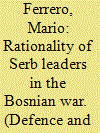| Srl | Item |
| 1 |
ID:
151400


|
|
|
|
|
| Summary/Abstract |
Existing theory on counterinsurgency does not adequately explain persistent insurrection in face of the reconstruction work currently underway in Afghanistan and Iraq. We starkly depart from the literature by developing a simple model of reconstruction allowing misalignment of occupier spending with community preferences. Insurgency arises endogenously as a result of the mix of spending rather than its level. Occupier insistence on its preferred path of reconstruction may lead to fewer projects of any kind being completed. In equilibrium, the occupier may accept an endogenous insurgency to achieve a preferred project mix, or be constrained in its choice even when no insurgency occurs.
|
|
|
|
|
|
|
|
|
|
|
|
|
|
|
|
| 2 |
ID:
151402


|
|
|
|
|
| Summary/Abstract |
This paper examines whether defense expenditures contributed to economic growth in China for the 1952–2012 period. We examine the contribution of defense to economic growth using recently published official data on economic activity, defense, and government expenditures. We employ the Feder-Ram and augmented Solow models of economic growth to explore the defense-growth relationship. The Feder-Ram model appears to poorly explain economic growth in China. The augmented Solow model suggests, however, that a 1% increase in defense expenditures raises the economic growth rate by approximately 0.15–0.19%.
|
|
|
|
|
|
|
|
|
|
|
|
|
|
|
|
| 3 |
ID:
151403


|
|
|
|
|
| Summary/Abstract |
China’s rapid economic growth is facilitating massive increases in its military spending and causing increased security concerns in Asia and the Western Pacific. But there is uncertainty over how large China’s military spending is relative to other countries, or how fast it is growing in real terms. We address this issue by deriving a relative military cost price index based on the relative unit costs of inputs. We find that China’s real military spending is much larger than suggested by exchange rate comparisons, and even larger than standard purchasing power parity comparisons. We also find, however, that the real growth of China’s military spending has been smaller than conventionally thought. This is due to rapidly growing wages in China and the large share of personnel in China’s military budget.
|
|
|
|
|
|
|
|
|
|
|
|
|
|
|
|
| 4 |
ID:
151399


|
|
|
|
|
| Summary/Abstract |
President Obama’s call for change in the conduct of US foreign policy shifts emphasis from direct interventions to cooperative partnerships. With a
billion pledge as support for their development, the issue of effectiveness and design is brought to the fore. If terror organizations cannot be eradicated, can a donor state successfully delegate the deterrence or at least the containment of a violent non-state actor to the host country from which it operates? We identify, assess for impact, and value rational delegated deterrence arrangements, in which the US subsidizes a host, and the host, with agreed upon vigor, inhibits the activity of the violent non-state actor operating within its borders. We account for the US’ imperfect monitoring of host and non-state actor activity and identify agreements that can successfully deter the targeted organizations. We also find that mutually agreeable weak cooperation between donor and host can endure despite the survival of the violent non-state actor on host territory.
|
|
|
|
|
|
|
|
|
|
|
|
|
|
|
|
| 5 |
ID:
151401


|
|
|
|
|
| Summary/Abstract |
This paper asks whether Bosnian Serb leaders’ choice to carry out a secession war in 1992–1995 was rational from the point of view of their stated goal of ethnic cleansing. We construct two indexes, one of ethnic purity and another of ethnic Serb concentration, and apply them to a counterfactual estimate of the outcome of ‘peaceful’ ethnic cleansing – what could have been achieved by population exchange based on pre-war territorial Serb power without war – in comparison to the actual outcome of the war. We find that the gross benefits of the chosen strategy of secession and war far exceed anything that could be achieved by the peaceful alternative. A conjectural assessment of perceived costs suggests that also net benefits were maximized by the war strategy. The implication for international deterrence policy is that credible judicial prosecution and punishment is the best way to alter the prospective perpetrators’ calculus.
|
|
|
|
|
|
|
|
|
|
|
|
|
|
|
|